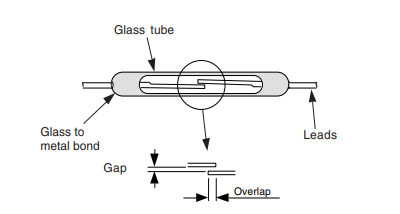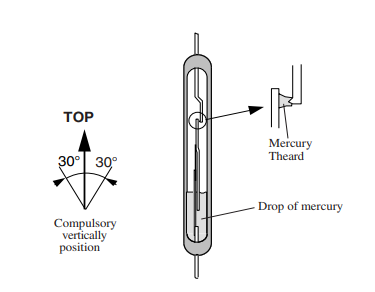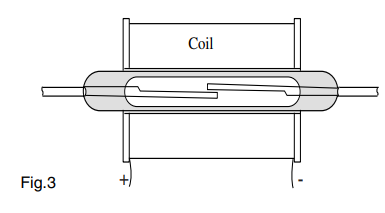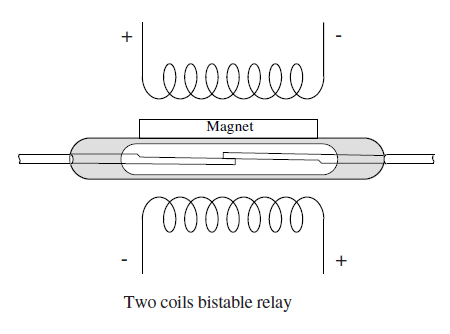Blog - EXPERTISE & INNOVATIONS - Reed Relays & Switches - REED Switches
The REED switch is the sensitive element of the magnetic sensor. It detects the presence of a magnetic field, usually a permanent magnet. It detects without contact the position of the magnet and transmits an electrical on/off or analog signal depending on the model.


A REED switch consists of two flattened ferromagnetic reeds which are sealed inside a glass tube, filled with an inert gas, which will come into contact under the influence of a magnetic field. The spring force of the reeds causes them to separate, and open the circuit, when the magnetic field ceases.
REED switches are manufactured in white room, on automatic sealing machines. Most reed switches are filled with nitrogen at atmospheric pressure. Since the contacts of the reed switch are sealed away from the atmosphere, they are protected against atmospheric corrosion. The hermetic sealing of a reed switch makes them suitable for use in explosive atmospheres where tiny sparks from conventional switches would constitute a hazard.
-No power supply necessary
-Operate in harsh environments,
-The sensing range can be very large (depending on the magnetic sensitivity of the switch, the power of the magnet as well as the magnetic environment),
REED switches are characterised by :
There are two types of REED switches :
A dry-reed switch assembly contains ferromagnetic contact blades, hermetically sealed in a glass envelope which is filled with an inert gas. The switch is operated by an externally generated magnetic field, either from a coil or permanent magnet. These switches can be used in any position. Like most mechanical contacts, they are subject to bouncing when they close. Depending on the type of switch the contact resistance is in the range of 50 to 150 milliohms, the switching capacity varies from 0,4 to 3 Amps., along with a switching voltage
Mercury wetted REED switches contain a drop of mercury which irrigates the contact area by a capillarity effect. Mercury wetted reed switches must be mounted in a particular orientation otherwise drops of mercury may bridge the contacts even when not activated. The advantage of a mercury wetted contact is that bouncing is avoided when the contacts close, that contact resistance remains very low throughout the useful life of the switch, and that a lifespan of over ONE HUNDRED MILLION cycles is available at nominal current levels.

Sensitivity is measured in units of ampere-turns (AT), corresponding to the current in a test coil multiplied by the number of turns in the test coil.
AT stands for Ampere- Turns.
This term is used to measure the sensitivity of a reed switch or the magnetic field needed to close the gap between the blades of the reed switch.
A low number like 1 means the switch is very sensitive.
In order to close a normally open switch, for instance, a certain number of Ampere-turns, called CAT, are required (closing Ampere-turns). To open the same switch the magnetic field must be reduced down to an opening value in OAT (Ampere-turns OAT).

All reed switch manufacturers measure AT differently. It is best to sample switches with a full range of AT values in your application to determine what truly works.
There are different contact types :
A contact which is normally open in the absence of a magnetic field will close in the presence of a magnetic field, it will be known as an “A” Form switch


A contact which is normally closed in the absence of a magnetic field will open in the presence of a magnetic field, it will be known as an “B” Form switch
This contact is obtained using a permanent magnet positioned against a type A switch. The power of the magnet is adjusted so as to close the switch. The magnetic field created by the relay coil must be directed in the inverse direction to that of the magnet, with the ability to shift the saturation point of the polarizing magnet.


A reversing REED switch includes a common reed, or blade, on one side, and two sealed contacts on the opposite side. When at rest the common Ferro-Nickel reed is mechanically biased against one of the contact in non magnetic material. This contact is known as an NC (Normally closed contact). Under the influence of a magnetic field, the common reed moves over onto the NO contact, which is in a magnetic material (NO = Normally Open). The NC circuit is then open. This type of switch is known as a “C” Form switch

This type of contact is obtained by the adjunction of a permanent magnet with sufficient magnetizing force to hold the switch in make, but too weak to close a contact in the open state.
In more detail, with a switch with a given CAT and OAT, the magnet is equivalent to AT magnet in such a manner that : CAT > AT magnet > OAT.
Under these conditions if the switch is open, it will stay open, if it is closed, it will remain closed as long as no current runs through the actuating coil.

The switching capacity of a switch is related to its dimension and to its manufacturing technology. It is characterized by :
-The maximum switchable power rate (expressed in Volts-Amperes)
-The maximum switchable amperage
-The maximum switchable voltage
To get more information about our range of reed relays & switches